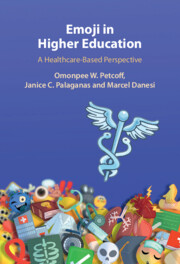Book contents
- Emoji in Higher Education
- Emoji in Higher Education
- Copyright page
- Contents
- Figures and Tables
- Foreword
- Preface
- 1 The Emoji Phenomenon Reviewed
- 2 Emoji Literacy as a Teaching Tool
- 3 Emoji in Healthcare Communications and Education
- 4 A Mixed Methods Study
- 5 Emoji across the Healthcare Landscape
- 6 Emoji in General Education
- 7 Implications and Applications
- References
- Index
1 - The Emoji Phenomenon Reviewed
Published online by Cambridge University Press: 30 May 2024
- Emoji in Higher Education
- Emoji in Higher Education
- Copyright page
- Contents
- Figures and Tables
- Foreword
- Preface
- 1 The Emoji Phenomenon Reviewed
- 2 Emoji Literacy as a Teaching Tool
- 3 Emoji in Healthcare Communications and Education
- 4 A Mixed Methods Study
- 5 Emoji across the Healthcare Landscape
- 6 Emoji in General Education
- 7 Implications and Applications
- References
- Index
Summary
Chapter 1 offers an in-depth, historically based discussion of the research on emoji and on matters of general concern regarding this unique type of visual character, along with a rationale for the need for a comprehensive treatment of emoji in education. The authors describe the reasons for focusing on higher education, particularly health professional education. They begin by examining the background work on emoji theory and research and offer initial insights into the discourse and semiotic functions of the emoji code. Such functions form the basis for considering the emoji code as a teaching tool that may be used to craft hybrid literacy-focused instruction (textual and visual). The discursive and recursive properties of emoji form the basis of semioliteracy, a theory that one of the authors (Petcoff) contends offers a basis for emoji use in developmental reading and writing and across several higher education academic fields. Specifically, the chapter addresses the potential use of emoji as a literacy instruction tool in both higher education and healthcare professional education.
Keywords
- Type
- Chapter
- Information
- Emoji in Higher EducationA Healthcare-Based Perspective, pp. 1 - 28Publisher: Cambridge University PressPrint publication year: 2024



